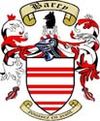Buttevant
|
Buttevant Cill na Mullach |
||
|---|---|---|
| Town | ||
 |
||
|
||
| Location in Ireland | ||
| Coordinates: 52°13′59″N 8°40′1″W / 52.23306°N 8.66694°W | ||
| Country | Ireland | |
| Province | Munster | |
| County | County Cork | |
| Elevation | 300 ft (100 m) | |
| Population (2016) | ||
| • Total | 1,752 | |
| Time zone | WET (UTC+0) | |
| • Summer (DST) | IST (WEST) (UTC-1) | |
| Area code(s) | 022 | |
| Irish Grid Reference | R540092 | |
Buttevant (Irish: Cill na Mullach, meaning "Church of the Summits" or Ecclesia Tumulorum in the Latin) is a medieval market town, incorporated by charter of Edward III, situated in North County Cork, Ireland.
While there may be reason to suggest that the town may occupy the site of an earlier settlement of the Donegans, Carrig Donegan, the origins of the present town are clearly and distinctly Norman, and closely connected with the settlement of the Barrys from the 13th century. Here they built their principal stronghold in North Cork.
Buttevant is located on the N20 road between Limerick and Cork and the R522 regional road. The Dublin–Cork railway line passes by the town, but the station, from which at the outbreak of World War I in 1914, newly raised battalions of the Royal Munster Fusiliers and the Royal Dublin Fusiliers who had completed their training at the local military barracks, set out for the Western Front.
Barry family: Boutez-en-Avant.Rotulus Pipae Cloynensis (1364) makes ten references to Bothon in its Latin text. The Lateran Registers record the name tempore Pope Innocent VIII as Bottoniam (7 March 1489) and Buttumam (3 June 1492); and tempore Pope Alexander VI in various forms: as "Bothaniam" (14 February 1499), "Betomam" (12 March 1499), and "Buttomam" (15 January 1500). Edmund Spencer, in Colin Clouts Come Home Againe (1595), gives an early example of the modern name and associates it with Mullagh, his name for the river Awbeg:
...
Wikipedia


